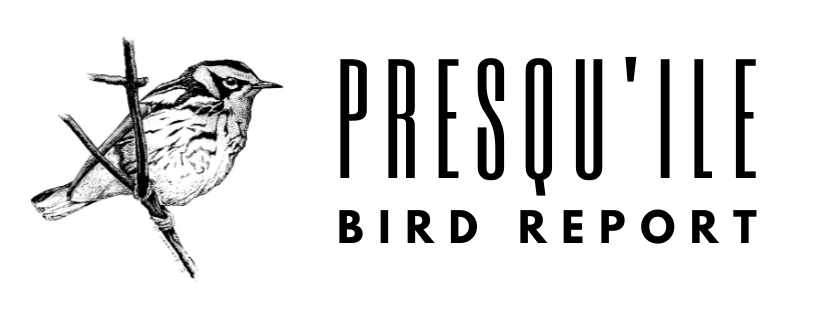
Presqu’ile Bird Report for 24-30 May 2019
HIGHLIGHTS: BRANT, RING-NECKED DUCK, RED-THROATED LOON, BIG SHOREBIRD GROUNDING, YELLOW-THROATED VIREO, KENTUCKY WARBLER, CLAY-COLORED SPARROW
This was probably the last big week of northbound migration, although some later migrants will continue for a few weeks. There were several days with good songbird migration and a big shorebird grounding occurred on 26 May.
Forty-eight BRANT were seen on 29 May. A lingering pair of RING-NECKED DUCK continues in the marsh off the Camp Office viewing deck. Five WHITE-WINGED SCOTERS were noted on 28 May. LONG-TAILED DUCKS can be seen far offshore on calm days with a high of 125 on 27 May. A few COMMON MERGANSERS were seen along with the more numerous RED-BREASTED MERGANSER, which peaked with 48 on 27 May. A RED-THROATED LOON in breeding plumage was off the beach on 27 May and three more there on 29 May.
Both AMERICAN and LEAST BITTERNS are putting on a good show with reports almost daily from the marsh off the Camp Office and the causeway (Presqu’ile Parkway) marsh. GREEN HERONS have been unusually scarce this spring but one was seen on 30 May. A nesting pair of NORTHERN HARRIERS was seen doing a food exchange on 27 May. VIRGINIA RAIL and COMMON GALLINULE were reported almost daily from the marsh.
A significant grounding of shorebirds, mostly DUNLIN and SEMIPALMATED SANDPIPER, occurred on 26 May when migrating birds were met with NW wind and fog. Although the beach is largely underwater the birds spread out on waters’ edge along the entire length of the beach and fed non-stop all day. The next morning almost all were gone. In all there were 3632 birds of 12 species on the beach. The high counts from various observers were as follows: 45 BLACK-BELLIED PLOVER, 4 SEMIPALMATED PLOVER, 4 KILLDEER, 4 SPOTTED SANDPIPER, 30 WHIMBREL, 1 RUDDY TURNSTONE, 40 SANDERLING, 2500 DUNLIN, 2 LEAST SANDPIPER, 1 WHITE-RUMPED SANDPIPER, 1000 SEMIPALMATED SANDPIPER, and 1 SHORT-BILLED DOWITCHER. In addition WILSON’S SNIPE and AMERICAN WOODCOCK were also present but not on the beach. Small numbers of BONAPARTE’S GULL were mixed with other gulls all week with a high of 18 on 28 May.
A Rock Pigeon, somewhat rare in the Park, was reported on 27 May. Most of our records refer to lost homing pigeons. COMMON NIGHTHAWKS were seen most evenings in small numbers near dusk with a high of 8 on 26 May. RED-HEADED WOODPECKERS are showing signs of nesting with copulating pairs seen at two sites. An OLIVE-SIDED FLYCATCHER was reported on 26 May. YELLOW-BELLIED FLYCATCHERS were seen on several days with a high count of 3 on 26 May. A YELLOW-THROATED VIREO, a scarce migrant at best, seen on 29 May was getting late. Similarly a BLUE-HEADED VIREO seen on 27 May was late. A CAROLINA WREN was reported without further details on 26 May. A HERMIT THRUSH on 29 May was very late.
Warblers were once again well represented this week with most expected species seen, especially the later migrants like BLACKPOLL, WILSON’S, CANADA and MOURNING. Unquestionably the star of the week was a stunning KENTUCKY WARBLER that sang its heart out for several hours near Jobes Woods on 26 May and allowed most local birders the chance to see this southern over-shoot at Presqu’ile for the first time.
Two CLAY-COLORED SPARROWS were reported singing in the Calf Pasture field through the week. A report of a VESPER SPARROW without further details was made on 26 May. Although this species nests sparingly in the area, it is unknown from the Park at this season.
Needless to say we local birders would love to hear promptly of any rarities that visitors find so if you see something rare, please feel free to call or text my cell (613-243-4161) or Bill Gilmour’s cell (613-475-4219) and we will get the word out to the local birding community. Thanks.
Directions: Presqu’ile Provincial Park is located on the north shore of Lake Ontario, just south of the town of Brighton. It can be reached from either Hwy. 401, or Cty. Rd. 2 and is well signed. A Park map can be found in the information tabloid available at the Park gate. Presqu’ile’s two offshore islands – Gull and High Bluff – support a large multi-species colonial bird nesting area and access is not permitted during the breeding season (10 March-10 September).


